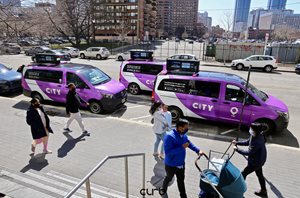 In Jersey City, Via’s 44 Mercedes vans (
In Jersey City, Via’s 44 Mercedes vans (eight are wheelchair accessible) and two electric vehicles cover a service zone of 15 square miles on weekdays from 6 a.m. to 10 p.m. and Saturdays from 8 a.m. to 10 p.m. Six of 10 trips connect to transit and 70 percent of rides are shared, according to Gardiner.
Since Via Jersey City launched in early 2020, it’s provided more than 1.25 million rides, averaging 57,000 per month or around 2,000 rides per day. In the third quarter of 2022, Gardiner estimated that Via helped to avoid more than 300,000 miles of single-occupancy vehicle (SOV) driving.
There have been questions about whether on-demand microtransit cannibalizes existing fixed-route services and if privatization is the answer for improving public transportation. Analysis by Via showed that less than 25 percent of trips taken by the service could have been served by existing transit services. “Via Jersey City is really showing that it’s enhancing, not taking away from, fixed-route services,” Gardiner said.
Jersey City also plans to integrate public transit service into its app, allowing riders to choose public transportation over Via, or see where they could connect a Via ride to transit.
.jpg.aspx?width=375&height=249) This city is spli
This city is split into two zones, a center zone concentrated around the downtown and an outer zone. Fares are $2.50 anywhere from the center zone to the outer zone; beyond the outer zone is an additional $0.50 per mile. Given the geography of Jersey City, fares don’t tend to be more than $5, he said. These fares cover only a portion of actual costs which in 2021 were $11.61 per ride, according to Gardiner.
More than half of users report a household income of less than $50,000, according to Gardiner, while 88 percent identify as minorities, 58 percent as women, and 68 are under the age of 35. Michael Manzella, Jersey City’s Director of Transportation, said Via is serving the exact population it was expected to, with ridership growing about 23 percent from 2021 to 2022 and approaching five passenger rides per hour.
The program is helping Jersey City meet other goals, including improving safety by reducing automobiles on the road, Gardiner said.
“The fact that people are able to access the service for the first and last mile is probably reducing pedestrian crossings at roadways and increasing pedestrian safety,” NJTPA Board Chair John W. Bartlett added.
Arjun Janakiram, Via’s funding policy researcher, said there are several federal funding programs that communities could use to create microtransit programs, including: